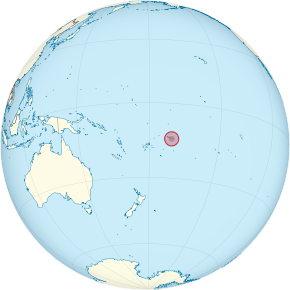
Back Samoa Amirika ACE Amerikaans-Samoa Afrikaans Amerikanisch-Samoa ALS አሜሪካዊ ሳሞዓ Amharic अमेरिकी सामोआ ANP ساموا الأمريكية Arabic ساموا الامريكيه ARZ Samoa Americana AST Amerika Samoası Azerbaijani آمریکا سامواسی AZB
American Samoa[c] is an unincorporated territory of the United States located in the Polynesia region of the South Pacific Ocean. Centered on 14°18′S 170°42′W / 14.3°S 170.7°W, it is 40 miles (64 km) southeast of the island country of Samoa, east of the International Date Line and the Wallis and Futuna Islands, west of the Cook Islands, north of Tonga, and some 310 miles (500 km) south of Tokelau. American Samoa is the southernmost territory of the United States, situated 2,200 miles (3,500 km) southwest of the U.S. state of Hawaii, and one of two U.S. territories south of the Equator, along with the uninhabited Jarvis Island.
American Samoa consists of the eastern part of the Samoan archipelago—the inhabited volcanic islands of Tutuila, Aunuʻu, Ofu, Olosega and Taʻū and the uninhabited Rose Atoll—as well as Swains Island, a remote coral atoll in the Tokelau volcanic island group. The total land area is 77 square miles (199 km2), slightly larger than Washington, D.C.; including its territorial waters, the total area is 117,500 square miles (304,000 km2), about the size of New Zealand.[6] American Samoa has a tropical climate, with 90 percent of its land covered by rainforests. As of 2024, the population is approximately 47,400 and concentrated on Tutuila, which hosts the capital and largest settlement, Pago Pago. The vast majority of residents are indigenous ethnic Samoans, most of whom are fluent in the official languages, English and Samoan.[7]
Inhabited by Polynesians since prehistory, American Samoa was first contacted by Europeans in the 18th century. The islands attracted missionaries, explorers, and mariners, particularly to the highly protected natural harbor of Pago Pago. The United States took possession of American Samoa in the late 19th century, developing it into a major naval outpost; the territory's strategic value was reinforced by the Second World War and subsequent Cold War. In 1967, American Samoa became self-governing with the adoption of a constitution; its local government is republican in form, with separate executive, legislative, and judicial branches. It remains officially unorganized and is thus directly administered by the federal government. American Samoa is listed among seventeen "non-self-governing territories" but is a member of several intergovernmental organizations, including the Pacific Community, Pacific Islands Forum (PIF), Alliance of Small Island States (AOSIS), and International Olympic Committee (IOC).[8]
Due to its strategic location, the U.S. military has a significant presence in American Samoa and plays a major role in its economy and society. The territory is noted for having the highest rate of military enlistment of any U.S. state or territory; as of 2021, the local U.S. Army recruiting station in Pago Pago ranked first in recruitment.[6][9] Tuna products are the main exports, with the U.S. proper serving as the largest trading partner. Tourism is a nascent but underdeveloped sector, owing in part to the territory's relative geographic isolation, which also accounts for its high rate of poverty and emigration.
Residents of American Samoa are politically disenfranchised, with no voting representation in the U.S. Congress. American Samoa is the only permanently inhabited territory of the United States in which citizenship is not granted at birth, and people born there are considered "non-citizen nationals" with limited rights. Citizenship is a controversial topic locally, as the government of American Samoa fears that it would lead to the erosion of traditional customs. It is the only U.S. territory with its own immigration system.
- ^ "U.S. Territories – Developments in the Law". Harvard Law Review. April 10, 2017. Retrieved June 11, 2024.
- ^ a b c Cite error: The named reference
CIAfactbookwas invoked but never defined (see the help page). - ^ Cite error: The named reference
census-countieswas invoked but never defined (see the help page). - ^ Cite error: The named reference
worldbankwas invoked but never defined (see the help page). - ^ "Gross domestic product for American Samoa increases for the second year in a row" (PDF). Bureau of Economic Analysis. Archived from the original (PDF) on May 13, 2017. Retrieved July 14, 2017.
- ^ a b "Our Islands". American Samoa Visitors Bureau. Retrieved May 25, 2024.
- ^ "American Samoa", The World Factbook, Central Intelligence Agency, July 11, 2024, retrieved July 24, 2024
- ^ "Local US Army recruiting station ranked #1 in the world – Samoa News". Archived from the original on April 2, 2015. Retrieved March 10, 2015.
Cite error: There are <ref group=lower-alpha> tags or {{efn}} templates on this page, but the references will not show without a {{reflist|group=lower-alpha}} template or {{notelist}} template (see the help page).


